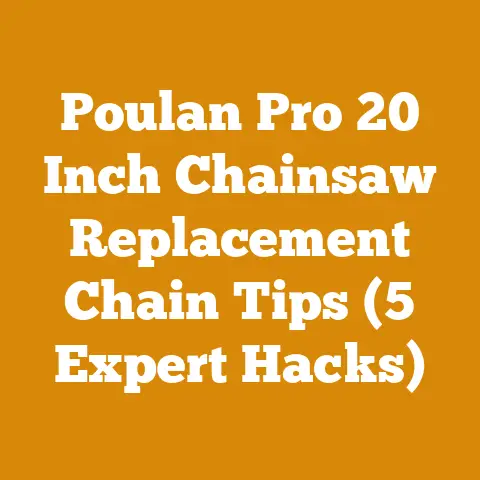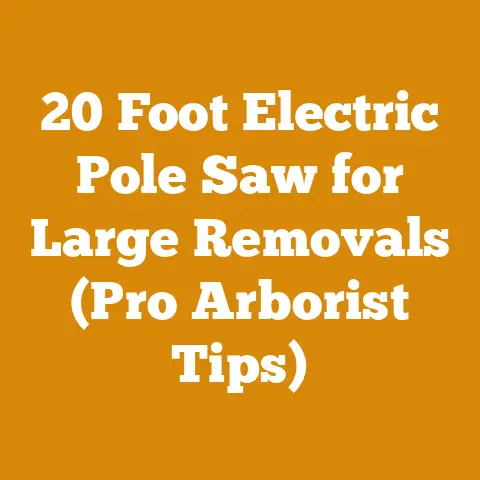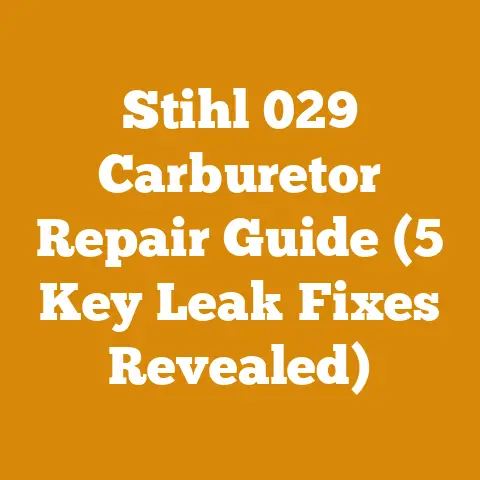Root Ball Removal Techniques (5 Pro Tips for Efficient Wood Processing)
Ever wondered what happens to the giant, tangled mess of roots left behind after a tree is felled?
Most people just see a stump, but I see a potential obstacle and a challenge in efficient wood processing.
Root ball removal is often overlooked, but it’s a crucial step in land clearing, forestry, and even firewood preparation.
Ignoring it can lead to significant delays, damaged equipment, and even injuries.
In this article, I’ll share my experiences and insights, along with five pro tips, to help you master root ball removal and streamline your wood processing operations.
The Importance of Root Ball Removal
Root balls are more than just unsightly remnants of trees.
They represent a significant volume of wood, often dense and difficult to process.
Leaving them in place can:
- Impede future land use: Planting new trees, constructing buildings, or even just mowing the lawn becomes a challenge with root balls in the way.
- Harbor pests and diseases: Decaying root balls can attract insects, fungi, and other organisms that can spread to nearby trees and plants.
- Pose safety hazards: Partially buried root balls can be tripping hazards or cause damage to vehicles and equipment.
- Reduce usable wood volume: Ignoring the root ball means leaving a significant portion of the tree’s biomass unused.
This is especially relevant if you’re aiming for maximum firewood production or timber harvesting.
Defining Key Terms
Before we dive into the techniques, let’s clarify some key terms:
- Root Ball: The mass of roots and soil attached to the base of a tree after it’s been felled.
- Green Wood: Freshly cut wood with a high moisture content.
It’s generally heavier and harder to split than seasoned wood. - Seasoned Wood: Wood that has been allowed to dry, reducing its moisture content.
Seasoned wood is lighter, easier to split, and burns more efficiently. - Stump Grinder: A machine specifically designed to grind down tree stumps and root flares into small chips.
- Excavator: A heavy construction equipment used for digging, demolition, and moving heavy objects.
- Winches: A mechanical device used to pull or haul heavy objects.
- Grubbing: The process of clearing land by removing stumps and roots.
5 Pro Tips for Efficient Root Ball Removal
Based on my years of experience in forestry and firewood preparation, here are five pro tips to help you remove root balls efficiently and safely:
Tip 1: Assessing the Root Ball and Choosing the Right Method
The first step is always assessment.
Not all root balls are created equal.
Factors to consider include:
- Size and Species: A small pine root ball is much easier to handle than a massive oak root ball.
Different tree species have different root structures, affecting the difficulty of removal.
For instance, some species have deep taproots, while others have shallow, spreading root systems. - Soil Type: Sandy soil is easier to work with than heavy clay.
Clay soil tends to cling to the roots, making removal more challenging.
Rocky soil can also present difficulties, as rocks can damage equipment and make digging more difficult. - Accessibility: Is the root ball easily accessible to machinery, or is it in a tight space?
- Desired Outcome: Are you simply removing the root ball, or do you need to salvage the wood for firewood or other purposes?
Based on these factors, you can choose the most appropriate removal method.
Here are a few options:
- Manual Removal: Using hand tools like axes, shovels, and mattocks.
This is suitable for small root balls or in areas with limited access. - Mechanical Removal: Using machinery like excavators, tractors, or stump grinders.
This is more efficient for larger root balls and land clearing projects. - Chemical Removal: Using herbicides to kill the tree and accelerate the decay of the root ball.
This is a slow process and may not be suitable in all situations. - Burning: Burning the root ball in place.
This is a quick and efficient method, but it’s subject to local regulations and may not be suitable in areas with dry vegetation.
My Experience: I once had to remove several large oak root balls from a property with heavy clay soil.
Manual removal was out of the question.
An excavator proved to be the most efficient solution, but the clay soil made the job challenging.
We had to use a high-pressure water jet to loosen the soil around the roots before lifting the root balls.
Tip 2: Utilizing Stump Grinders Effectively
Stump grinders are specifically designed to grind down tree stumps and root flares.
They are a versatile tool that can be used in a variety of situations.
Types of Stump Grinders:
- Walk-Behind Stump Grinders: These are smaller, more maneuverable grinders suitable for residential use and tight spaces.
- Tow-Behind Stump Grinders: These are larger, more powerful grinders that can handle larger stumps and root balls.
- Self-Propelled Stump Grinders: These are the most powerful and versatile grinders, suitable for commercial use and large-scale land clearing projects.
Operating a Stump Grinder:
- Safety First: Always wear appropriate safety gear, including eye protection, hearing protection, and sturdy gloves.
- Clear the Area: Remove any rocks, debris, or other obstacles from the area around the stump.
- Position the Grinder: Position the grinder so that the cutting wheel is directly over the stump.
- Engage the Cutting Wheel: Slowly lower the cutting wheel into the stump, moving it back and forth to grind down the wood.
- Grind in Layers: Grind the stump down in layers, working from the top down.
- Backfill the Hole: Once the stump is ground down to the desired level, backfill the hole with soil.
Optimizing Stump Grinder Performance:
- Sharp Teeth: Ensure the cutting teeth are sharp and in good condition.
Dull teeth will reduce the grinder’s efficiency and increase the risk of damage. - Proper Technique: Avoid forcing the grinder. Let the cutting wheel do the work.
- Maintenance: Regularly inspect and maintain the grinder according to the manufacturer’s instructions.
Case Study: I once used a tow-behind stump grinder to remove a row of old pine stumps from a property.
The stumps were quite large, but the grinder made the job relatively easy.
By using sharp teeth and proper technique, I was able to grind down each stump in about an hour.
The homeowner was amazed at how quickly and efficiently the stumps were removed.
Tip 3: Excavation Techniques for Large Root Balls
For larger root balls, an excavator is often the most efficient tool.
Excavators provide the power and reach needed to dig around the root ball and lift it out of the ground.
Excavation Process:
- Clear the Area: Remove any obstacles from the area around the root ball.
- Dig Around the Root Ball: Use the excavator to dig a trench around the root ball, exposing the major roots.
- Cut the Roots: Use an axe, chainsaw, or hydraulic shears to cut the exposed roots.
- Lift the Root Ball: Carefully lift the root ball out of the ground with the excavator.
- Transport the Root Ball: Transport the root ball to a designated disposal area.
Tips for Efficient Excavation:
- Start Wide: Begin by digging a wide trench around the root ball to provide ample working space.
- Work in Layers: Dig in layers, gradually exposing more of the root system.
- Use the Right Attachment: Consider using a root rake or other specialized attachment to help remove the root ball more efficiently.
- Be Patient: Excavating large root balls can be time-consuming. Be patient and work methodically.
Safety Considerations:
- Underground Utilities: Always check for underground utilities before digging.
- Slope Stability: Be aware of the slope stability and take precautions to prevent landslides.
- Equipment Operation: Operate the excavator safely and according to the manufacturer’s instructions.
My Insight: When excavating, I always try to preserve as much of the surrounding soil as possible.
This helps to minimize soil disturbance and makes it easier to backfill the hole.
I also use a combination of excavation and manual labor to carefully remove the root ball without damaging nearby trees or plants.
Tip 4: Splitting and Processing Root Ball Wood
Root ball wood can be a valuable source of firewood or other wood products.
However, it can also be challenging to process due to its density, irregular shape, and the presence of dirt and rocks.
Splitting Techniques:
- Axe Splitting: For smaller root balls, an axe can be used to split the wood.
Use a heavy splitting axe and aim for natural cracks in the wood. - Hydraulic Splitter: For larger root balls, a hydraulic splitter is the most efficient option.
Hydraulic splitters provide the power needed to split even the most stubborn wood.
Pre-Splitting Preparation:
- Clean the Wood: Remove as much dirt and debris as possible from the wood before splitting.
This will help to protect your splitting tools and reduce wear and tear. - Cut to Length: Cut the root ball into manageable lengths before splitting.
- Identify Weak Points: Look for natural cracks or weak points in the wood that can be exploited during splitting.
Wood Type and Moisture Content:
- Green Wood vs.
Seasoned Wood: Root ball wood is often green wood, which is harder to split than seasoned wood.
Consider allowing the wood to dry for several months before splitting. - Wood Species: Different wood species have different splitting characteristics.
Some species, like oak and maple, are notoriously difficult to split, while others, like pine and poplar, are easier.
Case Study: I once processed a large pile of root ball wood that consisted primarily of oak.
The wood was extremely dense and difficult to split.
I used a combination of axe splitting and hydraulic splitting to get the job done.
I found that the hydraulic splitter was essential for splitting the larger, more stubborn pieces of wood.
I also discovered that allowing the wood to dry for a few months made it significantly easier to split.
Equipment Specifications:
- Chainsaws: I use a Stihl MS 462 R C-M for cutting root balls, with a 25-inch bar.
The powerful engine handles the dense wood effectively. - Axes: My go-to splitting axe is a Gränsfors Bruks splitting maul.
Its weight and design make it ideal for splitting large rounds. - Log Splitters: I use a 34-ton hydraulic log splitter for processing larger root ball sections.
Tip 5: Proper Disposal and Land Restoration
Once the root ball has been removed and processed, it’s important to dispose of the remaining debris properly and restore the land.
Disposal Options:
- Landfill: Root balls can be disposed of at a local landfill.
However, this is often the least environmentally friendly option. - Composting: Smaller root balls and wood chips can be composted.
This is a good way to recycle the organic material and improve soil health. - Burning: Root balls can be burned in a controlled burn.
However, this is subject to local regulations and may not be suitable in all areas. - Repurposing: Some root balls can be repurposed for landscaping or other creative projects.
Land Restoration:
- Backfill the Hole: Backfill the hole with soil, compacting it as you go.
- Grade the Area: Grade the area to ensure proper drainage.
- Replant Vegetation: Replant vegetation to stabilize the soil and prevent erosion.
- Soil Amendment: Consider adding soil amendments, such as compost or fertilizer, to improve soil health.
Environmental Considerations:
- Erosion Control: Take steps to prevent erosion, especially on slopes.
- Water Quality: Protect water quality by preventing sediment runoff.
- Habitat Preservation: Preserve existing vegetation and wildlife habitat whenever possible.
My Approach: I always try to minimize the environmental impact of root ball removal.
I prefer to compost or repurpose root balls whenever possible.
When disposal is necessary, I choose the most environmentally friendly option available.
I also take great care to restore the land after root ball removal, ensuring that the area is stable, well-drained, and replanted with appropriate vegetation.
Strategic Insights for Efficient Wood Processing
Beyond the tactical tips, here are some strategic insights I’ve gained over the years:
- Planning is Key: Before you even start, develop a detailed plan that considers the size and location of the root balls, the available equipment, and the desired outcome.
- Invest in Quality Tools: Investing in quality tools will save you time and effort in the long run.
Choose tools that are durable, reliable, and appropriate for the task at hand. - Prioritize Safety: Safety should always be your top priority.
Wear appropriate safety gear, follow safe operating procedures, and be aware of potential hazards. - Learn from Experience: Every root ball removal project is a learning opportunity.
Take notes on what works and what doesn’t, and use that knowledge to improve your efficiency in the future. - Consider the Long-Term Impact: Think about the long-term impact of your root ball removal project on the environment and the surrounding landscape.
Choose methods that minimize soil disturbance, protect water quality, and preserve habitat.
Next Steps
Now that you’ve learned about root ball removal techniques, it’s time to put your knowledge into practice.
Start by assessing the root balls on your property and choosing the most appropriate removal method.
Gather the necessary tools and equipment, and be sure to prioritize safety.
As you work, remember the tips and insights I’ve shared in this article.
With practice and patience, you’ll become a master of root ball removal and streamline your wood processing operations.
Remember to consult local regulations and best practices for tree removal and land management in your area.
Good luck!






